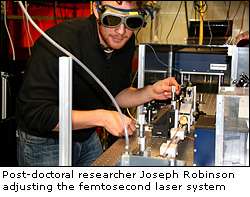Catching the wave -- Researchers measure very short laser pulses

Scientists have perfected a technique for very accurately measuring and controlling the electromagnetic waves within some of the shortest laser pulses ever made, says new research published today. Being able to fully understand and control these laser pulses represents an important step towards using them to track and manipulate electrons in leading-edge research at the sub-atomic level.
The study, published in Nature Physics, focused on extremely short laser pulses, less than 10 femtoseconds long - a femtosecond is one million-billionth of a second. These laser pulses can allow scientists to move and control the electrons in atoms and molecules, and to understand, for example, how molecules are formed. To achieve this reliably, the pulse of electromagnetic waves emitted from the laser must be controlled and measured with a precision which, until now, has been very hard to achieve.
The team of physicists from Imperial College London attained an unprecedented level of accurate measurement by firing the femtosecond laser pulse into a sample of gas, which responds by emitting an x-ray pulse which is even shorter in duration - up to 10 times shorter than the original laser pulse. The researchers found that the spectrum of the x-ray pulse has encoded within it all the information necessary to precisely reconstruct the waveform of the original laser pulse. Through careful measurements and some 'intelligent' software designed specifically for this purpose, the researchers were therefore able, for the first time, to measure the waveform of individual femtosecond pulses.
Dr John Tisch, one of the Imperial research team, said: "This measurement technique is so accurate that we can determine the position of a peak in the pulse of electromagnetic waves from the laser with a precision of a mere 0.05 femtoseconds - in other words, 50 attoseconds. Also, the measurement can be made on individual pulses rather than by looking at the average properties of many pulses, so this is an important step forwards."
Dr Tisch explains that not only will this new technique lead to a greater ability to use short laser pulses for accurate sub-atomic level research, but it also sheds new light on the extremely short x-ray pulses emitted in response: "The x-ray pulses we used in the measurement process of our research are of great interest in their own right," he says. "They are on the attosecond timescale, which is even shorter than a femtosecond - just one billion-billionth of a second. They are a new tool for scientists to probe even faster motion than the femtosecond pulses that triggered them."
The research team have recently received a four-year £2.5 million grant from the EPSRC to take this research to the next stage. Professor Jonathan Marangos explains: "Now we've perfected this technique, we are going to look into using our accurate measurements and control of these lasers to manipulate electrons and control quantum processes."
Citation: "Half-cycle cut-offs in harmonic spectra and robust carrier-envelope phase retrieval", Nature Physics, Sunday 3 December 2006.
Source: Imperial College London




















